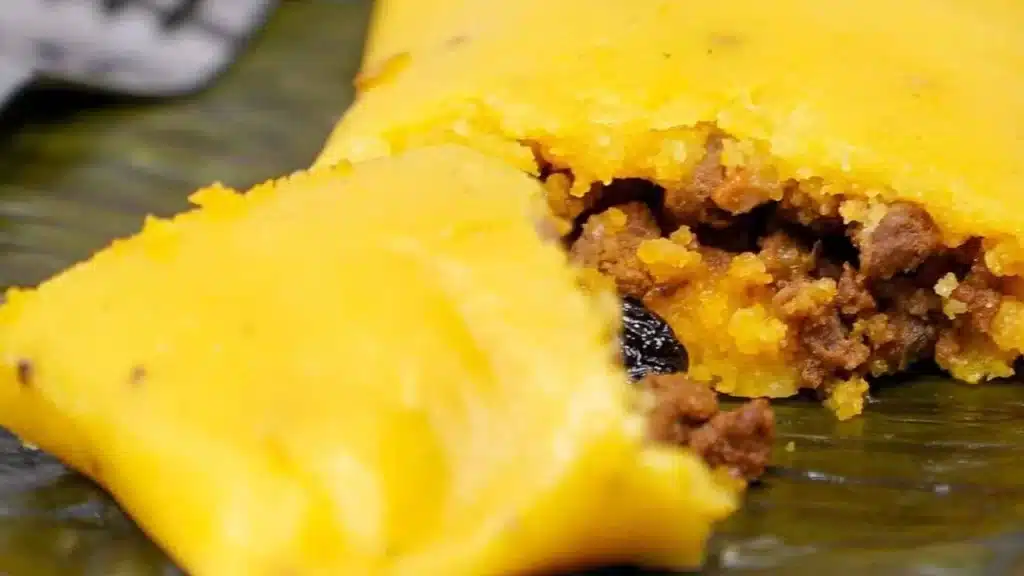In Trinidad and Tobago, Pastelle is a holiday essential, just like ginger beer, sorrel, and black cake. Its roots go back to when the Spanish colonized the island in the 15th or 16th century, possibly influenced by the indigenous Taino Arawaks.
During Christmas, Pastelles are a hot commodity in Caribbean homes. While the traditional method involves a meticulous process of making shells with savory fillings, this baked pie version simplifies the preparation. It combines all the flavors in a convenient one-pan dish, providing a more straightforward way to enjoy this festive treat.
Trinidad Pastelle, introduced by Spanish colonists, is similar to Tamales but differs as Tamales use corn masa exclusively. The sweet variation is known as Trinidad Paime.
Pastelle comes with various fillings, from beef and shredded chicken to vegan options like lentils or spinach. My top pick is the beef version—a savory cornmeal pie filled with seasoned meat. This steamed delight is a cherished part of Caribbean Christmas cuisine.
No more heating fig leaves, flattening cornmeal balls, or wrapping in banana leaves. It’s a delightful fusion of minced meat, capers, and cornmeal baked into a savory casserole, reminiscent of Christmas gatherings when we enjoyed these delicious treats with family.
As you sauté minced meat, onions, and bell peppers, the sizzling melody fills the air. Thyme and garlic join in, signaling something extraordinary is underway. This isn’t just a pie; it’s a celebration of flavors.
As the timer ticks away, your kitchen transforms into a Trinidadian carnival of scents. The pie emerges, a golden marvel, with a crisp crust cradling the flavorful medley within. Slice into it, and you’re met with a chorus of textures and tastes—a culinary crescendo that transports you straight to the vibrant streets of Trinidad.
The Story Behind The Recipe
Once upon a time in Trinidad and Tobago, there was a cherished dish known as pastelle. This delightful creation was a steamed cornmeal pie filled with seasoned meat, olives, raisins, and an array of spices, all wrapped up in a banana leaf. It was a beloved tradition, especially during the festive holiday season. Now, picture someone taking the essence of pastelle and transforming it into a baked pie, giving birth to the Trinidad Pastelle Pie.
This culinary twist involves encapsulating the aromatic spices and tantalizing mix of ingredients in a golden, flaky crust. It’s a fusion of tradition and creativity, a delightful deviation that captures Trinidad’s diverse culinary heritage.
As time went on, the recipe for Trinidad Pastelle Pie likely passed through generations. Each cook added their unique touch, infusing the dish with a sense of personal flair. It became a celebration of Trinidadian flavors, a nod to the cultural diversity that defines the island.
So, when people on the island shared a slice of Trinidad Pastelle Pie, they weren’t just enjoying a tasty dish. They were savoring the history, the festivities, and the creativity that defined Trinidadian cuisine. Each bite became a delightful exploration of tradition and innovation, echoing the vibrant spirit of the island. And that, my friends, is the story behind the Trinidad Pastelle Pie recipe.
You May Like
How To Cook Trinidad Pastelle Pie

Ingredients
- 1 cup all-purpose flour
- 2 cups cornmeal
- 1 cup unsalted butter
- 1 teaspoon salt
- 1 cup water
For filling
- 1 lb chicken and beef, minced
- 1 cup bell peppers, diced
- 1 cup onion, chopped
- 1 cup tomato paste
- 3 cloves garlic, minced
- 1 cup raisins
- 1 teaspoon thyme
- 1 cup pimento-stuffed olive, sliced
- Salt and pepper (according to taste)
Step By Step Instruction For Making Trinidad Pastelle Pie
- In a big bowl, mix together cornmeal, flour, and salt.
- Melt butter in water on the stove over medium heat, and then pour it into the dry ingredients.
- Knead the mixture until it becomes smooth, stretchy dough.
- In a separate pan, cook the minced meat until it browns.
- Add onions, garlic, and bell peppers to the meat. Cook until the veggies are soft.
- Stir in tomato paste, thyme, salt, and pepper.
- Add raisins and olives to the mix. Let everything simmer to perfection.
- Split the dough into two parts.
- Roll out one part to fit the bottom of your pie dish.
- Spoon in the tasty filling.
- Roll out the second part for the top crust of the pie.
- Seal the edges and make a few slits on top for steam to escape.
- Bake in a preheated oven at 375°F (190°C) until the crust turns a lovely golden brown.
Tips for making Trinidad Pastelle Pie
- Make sure the edges of the pie are sealed well so the filling doesn’t leak while baking. You can use a fork to press the edges together or use your fingers to make decorative patterns.
- Getting the crust just right is important. Make sure your dough is kneaded well for elasticity. When rolling it out, aim for a thickness that gives a nice balance between flakiness and structure.
Flavourful substitute
- All-purpose flour: you can use gluten-free flour instead of all-purpose flour.
- Unsalted butter: you can use salted butter instead of unsalted butter but adjust the salt in the recipe accordingly.
- Thyme: you can use oregano instead of thyme.
Serving suggestions
- Fresh Greens: Create a balanced plate by pairing the pie with a simple salad. Fresh greens with light vinaigrette can complement the richness of the pie.
- Coconut Accents: Bring a taste of the Caribbean by adding coconut-based sides. Coconut rice or a refreshing coconut slaw can enhance the tropical experience.
- Avocado Delight: Sliced avocado or guacamole can add a creamy element to the meal, providing a cool contrast to the warm and savory Trinidad Pastelle Pie.
- Pepper Sauce Kick: For those who love a bit of heat, provide different types of pepper sauces on the side. This allows each person to customize the spice level according to their preference.
- Fruit Medley: Create a fruit salad with a mix of tropical fruits like pineapple, mango, and papaya. The sweetness can contrast nicely with the savory notes of the pie.








